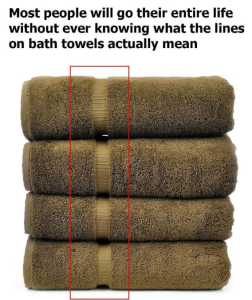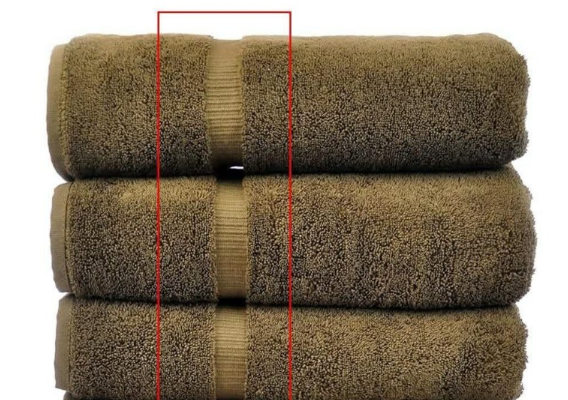Have you ever noticed those curious lines woven into your bath towels—the slightly raised or indented bands that often run horizontally across the fabric? Most people never give them a second thought. They seem like a simple design flourish, something to make the towel look a little more elegant on a bathroom shelf.
But here’s the twist: those mysterious lines aren’t just for decoration. They serve several clever and practical purposes that most of us have never even considered. From improving absorbency to making your laundry life easier, those little lines carry a lot of weight in the overall function of a towel.
Let’s unravel the hidden story behind them.
1. They Help Towels Dry Faster
Towels are designed to absorb water—but they also need to dry out quickly afterward to prevent mildew and odors. The lines (often called “dobby borders”) create a subtle break in the dense pile of the towel. That break improves airflow when the towel is hanging on a rack or line.
Think of it like ventilation: by disrupting the flat surface of the towel, the lines allow air to circulate more easily through the fabric. This can make a big difference in how quickly the towel dries after a shower. A towel without these lines would remain more compact and trap moisture longer, leading to that damp smell everyone dreads.
2. They Prevent Shrinkage and Warping
If you’ve ever noticed that towels sometimes get a wavy or distorted shape after several washes, the dobby border is actually designed to minimize that. The tighter weave of the line acts almost like a stabilizer or anchor.
When towels are washed and dried, they expand and contract with the heat and moisture. The smooth border helps hold the towel’s shape so it stays rectangular instead of stretching out or curling at the edges. That’s why even after many laundry cycles, good-quality towels maintain a crisp, even look.
3. They Make Folding and Stacking Easier
This is a subtle benefit but a real one—especially for hotels, spas, or anyone who loves a tidy linen closet. The line often runs at a consistent position on every towel, giving you a natural “guide” for folding.
When towels are folded along the border, they stack neatly and uniformly. This is why you often see perfectly aligned towels in luxury hotels or showrooms. It’s not just housekeeping skill—it’s also the fabric’s design working with the person folding it.
4. They Signal Quality and Craftsmanship
Not all towels have these lines, but the ones that do are often more carefully manufactured. The dobby border requires a slightly more complex weaving technique. High-quality towel makers use these lines as a signature—an indicator that the towel is made to last.
Many premium brands add unique patterns, textures, or widths to the border, making it part of their identity. If you pay attention, you might even start to recognize brands or quality levels just by looking at the design of the line.
5. They Keep the Towel from Unraveling
This may be the most practical reason of all. The line is woven more tightly than the rest of the towel, and it acts as a barrier to stop fraying. Over time, the loops in a towel can loosen, especially after repeated washing.
But the dobby border locks the threads in place, reinforcing the edges so the fabric doesn’t start to pull apart from the inside out. This small feature can significantly extend the life of the towel, saving you from replacing them as often.
6. They Help Absorbency Stay Balanced
It might sound strange, but not every part of a towel should behave the same way. The fluffy, looped sections are designed to soak up water. The flat, tight dobby lines are not as absorbent—and that’s intentional.
This difference helps control how the towel absorbs and dries. By concentrating absorbency in the main body of the towel and leaving the border less absorbent, the towel doesn’t stay soaked from edge to edge. That contributes to quicker drying and less mildew buildup.
7. They Add a Touch of Style and Personality
While the function is important, aesthetics do play a role. Towel makers often use the dobby border to create elegant patterns—lines, squares, geometric shapes, or even intricate weaves.
This simple design element can make a towel look more refined and spa-like without needing flashy prints or bold colors. It’s subtle sophistication—perfect for both minimalist bathrooms and more luxurious spaces.
8. They Help Differentiate Sizes and Sets
If you’ve ever reached into a stack of towels trying to guess whether it’s a hand towel, bath towel, or bath sheet, you’ll appreciate this detail. Some towel sets use different border widths or patterns for each size.
For example, a bath towel might have two thick bands, while a hand towel has a single narrow one. This makes organizing and identifying towels much easier, especially in households where several sets are in use.
9. They Offer a Natural Grip Point
Ever tried wrapping a heavy, water-soaked towel around your body? The smooth border actually gives your hands a better grip than the fluffy pile. That makes it easier to adjust or hang the towel without it slipping through your fingers.
It’s also why many people instinctively grab the towel near the line when hanging it up or folding it. The fabric feels firmer and more stable there.
10. They Have a Historical Purpose, Too
The dobby border isn’t new. It’s a textile tradition that goes back centuries. Weavers added flat bands to towels and linens to distinguish handmade products from simple woven cloth.
Over time, the technique evolved from purely functional reinforcement into an art form. In many places, the style of the border was even used to identify the workshop or region where a towel was made. Today, the tradition continues, blending history with modern function.
How to Care for Towels with Dobby Borders
Since these lines are woven differently from the rest of the towel, they can also wear differently. Here are a few quick tips to keep them in good shape:
-
Avoid overdrying: High heat can cause the borders to shrink faster than the towel pile. Use medium heat instead.
-
Don’t pull loose threads: If a thread appears in the border, trim it with scissors rather than pulling.
-
Fold along the border: This reduces stress on the weave and keeps the towel neat.
-
Wash in cool or warm water: Hot water can weaken fibers over time.
The Small Detail That Makes a Big Difference
Those simple, elegant lines near the edge of your towel are more than just pretty accents. They’re carefully engineered features that keep your towel looking good, feeling soft, drying fast, and lasting longer.
The next time you wrap yourself in a towel, run your fingers over those smooth lines and remember: they’ve been quietly working for you all along—preserving shape, preventing mildew, and adding a touch of craftsmanship to an everyday object.
It’s proof that even the smallest details in household items can have fascinating and functional stories hidden behind them.

